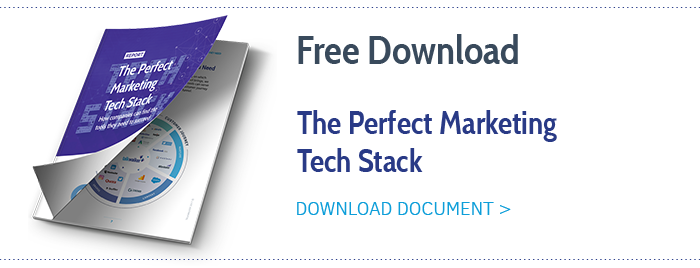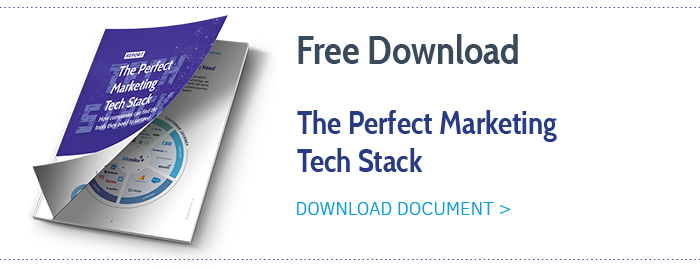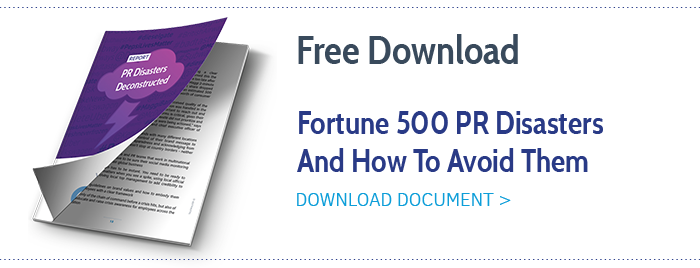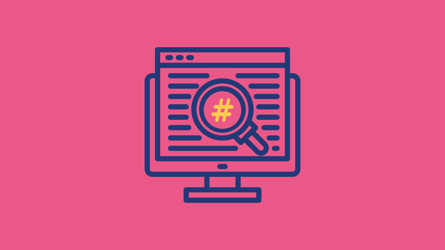1. What is a social media command center?
2. Why brands need command centers
3. The evolution of the command center: from the social war room to year-round monitoring
4. 7 ways a social media command center will empower your brand
5. The best social media war rooms examples
What is a social media command center?
A social media command center is a specific space where employees from different departments can visually monitor their brand, engage with customers and extract business insights year-round. It is usually composed of several screens displaying data visualizations from different sources.
Why should YOU get a command center?
Setting up a command center is an investment in time and resources, but here are a few reasons you should consider one for your brand as opposed to simple social media monitoring:
-
Break down the data silos: a command center will promote collaboration within your team as well as with other departments, and will change the way data is shared within your company.
-
Take more informed decisions: a command center will take the guesswork out of your decision making by presenting you with real-time data insights to optimize your strategy.
-
Facilitate access to data: with a command center, data is no longer something that is inaccessible and hard to comprehend - it is presented through well-chosen visualizations to maximize impact and information availability.
-
Showcase your results: A command center will give visibility to your digital efforts, as well as to the way your brand is perceived on social and beyond.
“We run our command center in the office, which is a magnet for people all over the company. It’s made a huge difference in the way data is shared with different teams. Almost everyone stops by regularly to look at it and take some information to their own teams.”
Elena Melnikova (@ElenaMMelnikova) | CMO at Talkwalker
The evolution of the command center: from the social war room to year-round monitoring
The concept of a social data center, or social room has greatly evolved over the last few years. As early as 2010, visionary companies such as Dell or Cisco started feeding social data into their customer service centers. The next step was the advent of “social rooms”, also called “social media war rooms”, created by giant brands such as Coca-Cola or the Dutch airline KLM to handle the social element of campaigns (such as the famous #HappyToHelp week) or specific events (e.g. March Madness).
KLM takes ‘social customer service’ to a new level during its #HappyToHelp week http://t.co/QLY5n6Y6i7 pic.twitter.com/rohKVCBTA1
— AirlineTrends (@airlinetrends) 20 octobre 2014
But these one-shot initiatives were costly to implement and often difficult to pull off, since the involved teams were not used to the exercise. In today’s society, social media monitoring is no longer something you do once a year to address a crisis or a big event, as the name “social media war room” seems to suggest.
These disadvantages have led several social media experts to call for the death of the social media war room in favour of couch-based real-time marketing operations. Companies such as Avocadoes from Mexico find new low-tech, inexpensive ways to coordinate their campaigns nationwide, such as a WhatsApp group to manage the social media buzz surrounding their Thanksgiving parade float.
In recent years however, the social media war room has made a comeback as a permanent space to monitor social media in real-time to protect the reputation of a brand, reply to customers and identify potential threats.
7 ways a social media command center will empower your brand
If you're looking to get a social room for your own brand, the timing has never been better. Here are first a few questions you should ask yourself before doing anything:
-
What are your objectives, and which information do you want to extract from social?
-
Who are the main stakeholders that will use the command center? (here's a great article about the people you need in a social media war room!)
-
Where will you place your command center?
-
Which data sources will you be using?
-
What type of visuals will be most effective?
-
How will you transform the insights unveiled by your command center into action?
To help you answer these questions, we’ve compiled a list of possible use cases for command centers. These objectives are by no mean exclusive, but the nature of your main objectives will impact the content and presentation of your company's command center.
1. Showcase your brand’s digital presence
A command center can be a great opportunity for a brand to make its employees, partners, and visitors more aware of the level of discussions it generates on social. In this case, the screens are usually placed in a public place, such as the atrium of a building or an open-space office, so as to allow many people to stop by to take in the digital presence of the brand.
For this type of social media command center, the level of complexity of the data visualizations should be low, as the goal for the command center is to be easily understandable for people with little social media knowledge. Visual effect is paramount: the goal is to wow visitors and employees and get them to share pictures of the display.
At the newly opened #socialbeam command center in Mumbai, heart of @capgemini expert connect program 1/2 pic.twitter.com/82WPPvNOa7
— Emmanuel Lochon (@emmanuellochon) 23 mars 2017
2. Check your brand reputation and monitor your competitors
Protecting a brand’s reputation is one of the primary use cases for command centers. This specific set-up will allow your marketing, social media and PR team to monitor the evolution of brand mentions and share of voice, as well as the activity of your brand’s main competitors.
3. Product/campaign launch: optimize your message
With the release of the next iPhone, the social response will be instant. People will be commenting on its new features, complaining about the ones that disappeared and comparing it to similar products. All the conversations surrounding a product launch are opportunities for the brand to interact with its customers, get more insights into their users' experience and optimize the message of their marketing campaigns with real-time feedback. A command center will allow you to centralize all these insights to analyze them and react accordingly at the different stages of the launch.
4. Event monitoring: enhance event experience
This set-up works particularly well for brands who have recurring events. For this case figure, you usually have a screen where the event is live-streamed, while the others present how it is experienced by people watching it at the venue or from another location. This model has become increasingly popular in professional sports associations (here are some "rules of engagement from the NBA's social media war room"!).
The @Dodgers social media command center #LetsGoDodgers pic.twitter.com/DpPQqyxh4U
— Ideacage (@ideacage) 5 juin 2017
5. Crisis management: detect crisis signals in real-time
Here’s an example for the French railway (SNCF), who have a specific social room to monitor the different ways the SNCF brand can be mentioned online and beyond. Just imagine how many annoyed travelers can tweet at the same time if several trains programmed to leave for the seacoast get canceled at the same time! This set-up allows the French railway company to detect the early signs of a crisis, wherever it gets sparked, from the blogosphere to social networks, and react instantly to control its spread.
Ce live-tweet en compagnie des #CMSNCF est désormais terminé. Dernier détour par la salle de crise lorsque ça devient vraiment chaud pic.twitter.com/HUXx76v3r5
— Aurore Coulaud (@AuroreCoulaud) 28 juillet 2017
The first panel of their command center displayed above is dedicated to web analytics: it tracks the flow of visitors on the company’s website. The next one tracks the number of blogs published about the SNCF over the past week, then the number of articles published by the online press. The two last screens are dedicated to social media, with information such as the top hashtags, the frequency at which the #SNCF hashtag is mentioned on social, and the live publications mentioning the railroad in any way, with an indication of the evolution of this number of mentions.
Community managers also use social listening to monitor specific expressions on social, such as “in the train”, “in the station” or “on the platform”, for example.
6. Customer service: find new ways to interact with your audience
This command center set-up brings up not only the social messages explicitly mentioning your brand but also those linked to topics of interest, which will allow you to engage with new segments of audiences and draw them into your brand community. A great example of that trend is the Hilton Hotels chain, which uses his Twitter account @HiltonSuggests to provide declared tourists all over the world with local tips for their stay.
Hi! I would suggest @PAUL_BAKERY or @pastry_parlour for some delicious croissants! I hope this helps? :) #London ^JK
— Hilton Suggests (@HiltonSuggests) 28 juillet 2017
7. Business insights to refine your strategy
MasterCard employees use a social media command center to identify in real-time their most effective advertising messages in over 60 markets and guide their ad spend decisions. The advantage of this command center approach is that it gives Mastercard better access to data rather than fighting to collect it from other partners or departments. For deeper insights, make sure to cross social data with your internal insights (sales figures, lead count, etc) and other data sources such as Google Analytics.
The best social media war room examples
How does it look in practice? I’ve already shown you a few in the use cases section of this blog, but here are some more with different levels of sophistication, from the sports to the finance and hospitality industries.
-
Gatorade's Mission Control
The US beverage brand uses its social room on a day-to-day basis to increase engagement, optimize its landing pages and monitor its various marketing campaigns. Got to love the name they selected for their command center: Gatorade Mission Control.
Spending the day @PepsiCo sharing ideas, getting an inside view of @Gatorade social media mission control center pic.twitter.com/6XlPIbgnad
— Olman Hernandez (@OlmanHernandez) 3 mars 2016
-
Mastercard: taking the pulse of a global audience
In this Forbes video, Mastercard CMO Raja Rajamannar discusses how the Mastercard Command Center helps the brand take the pulse of its global audience, identify new opportunities and stay ahead of the curve.
“(…) We were doing some social listening and some engagement, but it was nothing like we are doing today,” said Marcy Cohen, VP and Senior Business Leader for Worldwide Communications at Mastercard in a Digiday article. “Today, almost everything we do is rooted in insights we’re gathering from the conversation suite, transforming the way we do business. Our processes have changed.”
-
The Red Cross Digital Operations Center
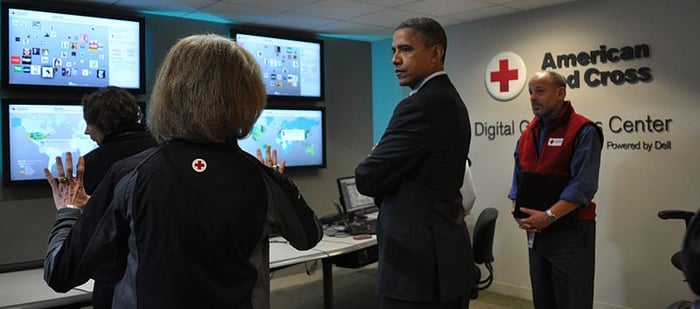
Image credit : Wikipedia Commons
-
Marriott’s Social Media Command Center
Marriott’s command center is monitored by its very own “M Live team”, which listens to what is being said about their brand and their 5700+ locations on all platforms, from Reddit to Instagram and Weibo and sometimes takes the opportunity to surprize its guests with free champagne ;-).
Posted by: NealSchaffer #Socialmedia Marriott brings its social media war room to Europe https://t.co/4WtbUK5sry … pic.twitter.com/RnkJLF04Ll
— Social Media tips (@Ads_SocialMedia) 2 janvier 2017
-
Axa Singapore’s Social Media Command Center
New Digital Command Center with @Leo_Singap @AXA Singapore. More to come at @AXA_Asia @fredtardy @JDrouffe @AOC1978 pic.twitter.com/htAO5rQKDJ
— Thierry Fabing (@ThierryFabing) 19 avril 2017
-
CES2017’s Social Media Command Center
The social media command center at #CES2017 is rockin! I'll be joined by a few surprise guests soon so stay tuned pic.twitter.com/tG6llHo4rA
— Ranson Burkette (@ransonbb) 5 janvier 2017
- Vodafone India's Social Media Command Center
Another step closer to the consumer. Brand team starts the day at the social media command Center #Consumerchatter #Twitter trends&cupcakes pic.twitter.com/RdzMBTmVbQ
— Neha Ahuja (@Neha_Ahuja09) 13 décembre 2016
- American Airlines' Social Media Command Center
How real-time #social networking has become a fully integrated aspect of @AmericanAir https://t.co/mddelShSQI via @dmscott
— Paul Lewis (@paul_a_lewis) 2 août 2017
- Dell's Social Media Command Center at #DellEMCWorld
#DellEMCWorld Social Media Command Center Bling cc @bellaboutet & @CaseyJerk pic.twitter.com/tHu6VgafwS
— Thom Lytle (@ThomLytle) 8 mai 2017
Want to give it a spin?
For Talkwalker users, a command center comes as an add-on. Please contact us to discuss how we can help you set up very own social media war room!

